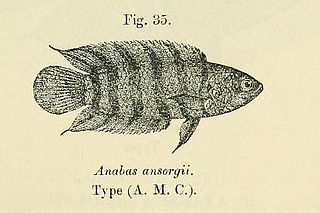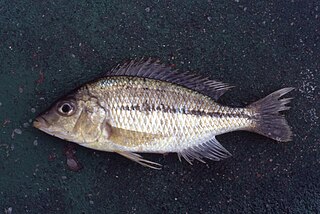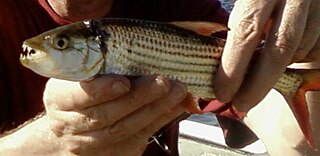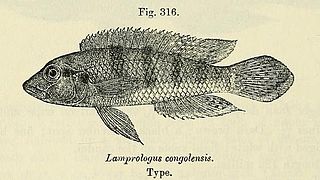
The Congo tetra is a species of fish in the African tetra family, found in the central Congo River Basin in Africa. It is commonly kept in aquaria.

Microctenopoma ansorgii is a small freshwater fish, known in the aquarium trade as the ornate ctenopoma, orange ctenopoma, ornate climbing perch, pretty ctenopoma, or rainbow ctenopoma. It is related to the more familiar spotted climbing perch, but looks very different. Its body is more elongated and rounded, with fins with red and black stripes; the color intensifies when the fish are displaying, with black bars becoming visible on the body. The ornate ctenopoma spawns at night, laying its eggs on a floating bubble nest like its relatives in the osphronemidae. It lives in the slow-flowing forest streams of the Congo Basin, where it feeds on worms, insect larvae, and other aquatic invertebrates. It is the most common member of its genus in the aquarium trade, where it is known for being a shy, easily bullied fish that needs live or frozen foods and which benefits from the presence of smaller dither fish to encourage it to come out of hiding.

The convict julie is a cichlid species in the subfamily Pseudocrenilabrinae family endemic to Lake Tanganyika. Hence it is found in Burundi, the Democratic Republic of the Congo, Tanzania, and Zambia. The fish is named after Charles Tate Regan.
Microctenopoma damasi is a species of fish in the family Anabantidae. It is found in the Democratic Republic of the Congo and Uganda. Its natural habitat is rivers. This species was formally described in 1939 as Anabas damasi by the Belgian ichthyologist Max Poll, the type locality given was Semliki River at Ishango in the Democratic Republic of Congo. The type was collected by Hubert Damas (1910-1964) of the University of Liège and when he described the species Poll named Damas as co-author, this meant that Damas was the co-author of a specific name which honoured himself.

Microctenopoma is a genus of fish in the Anabantidae family. They are native to Africa. Microctenopoma has been included in Ctenopoma in the past; unlike that genus, they are bubblenest builders, and the males defend the eggs and fry until they are free swimming.

Protomelas kirkii is a species of cichlid endemic to Lake Malawi where it is most commonly found in areas vegetated with Vallisneria. This species can reach a length of 18 centimetres (7.1 in) TL. This species can also be found in the aquarium trade.

The peaceful betta or crescent betta, Betta imbellis, is native to Southeast Asia, where it occurs naturally in Southern Thailand, Malaysia, and Indonesia, and has been introduced to Singapore. It is an inhabitant of stagnant waters in swamps, rice paddies, ditches, and pools. This species grows to a length of 6 cm (2.4 in). It is found in the aquarium trade.
The harlequin sharkminnow is a freshwater cyprinid fish from central Africa. It is also known as the harlequin shark and variegated shark, especially in the aquarium hobby.

Jae barb or Dja barb, Enteromius jae, is a species of cyprinid fish which like other sub-Saharan "barbs" was formerly placed in the genus Barbus, it has now been reallocated to Enteromius.

Pareutropius debauwi is a species that belong to the Order Actinopterygii, ray-finned fished, and can be placed in the Schilbeidae family, Schilbid catfishes. This family includes 9 genera and 46 species. The common name for Pareutropius debauwi is the African glass catfish.

The yellow-tailed African tetra is a freshwater fish that lives in the Congo River basin. It is found in both the Democratic Republic of the Congo and the Republic of the Congo. It is an omnivore in the wild which feeds on crustaceans, fallen fruits and small insects, but seems to have little difficulty in adjusting to normal aquarium foods. though they can be fed in aquarium with daphnia, bloostorm and artemia along good quality dried flakes and granules at least some of which should include additional plant or algal content. The species can tolerate water up to 20 degrees DH, though it does better in softer water. A temperature of 22–26 °C (72–79 °F) and a pH of between 5.0 and 7.5 and a hardness of between 36 and 268ppm is suitable. adult male are more colorful and tend to grow faster than females. males also develops extended white-tipped dorsal, ventral, caudal and anal fins which females lack. it is an egg scattered exhibiting no parental care, and one method of breeding is apparently to keep a group of adults in their own aquarium furnished with a kind of artificial trap, checking it regularly as much as possible especially for eggs. these are removed and normally hatched in smaller containers with the fry being offered microscopic foods until large enough to accept daphnia, bloostorm and the rest.
Microctenopoma nigricans is a fish in the family Anabantidae found in the Lulua and Sankuru River drainages, tributaries of the Kasai River in south-central Democratic Republic of Congo. It grows to 6.8 cm in standard length.
The mottled eel, also known as the African mottled eel, the Indian longfin eel, the Indian mottled eel, the long-finned eel or the river eel, is a demersal, catadromous eel in the family Anguillidae. It was described by John McClelland in 1844. It is a tropical, freshwater eel which is known from East Africa, Bangladesh, Andaman Islands, Mozambique, Malawi, Sri Lanka, Sumatra, and Indonesia and recently from Madagascar. The eels spend most of their lives in freshwater at a depth range of 3–10 metres, but migrate to the Indian Ocean to breed. Males can reach a maximum total length of 121 centimetres and a maximum weight of 7,000 grams. The eels feed primarily off of benthic crustaceans, mollusks, finfish and worms.

Coris cuvieri, the African wrasse, African coris or false clowwrasse, is a species of marine ray-finned fish from the wrasse family Labridae which is found in the Indian Ocean and the Red Sea. It is sometimes found in the aquarium trade.

Hemichromis lifalili, common name blood-red jewel cichlid, is a species of fish in the family Cichlidae.

Pseudocrenilabrus philander or the southern mouth-brooder is a small species of haplochromine cichlid found in southern and central Africa. It was first described by the German-Dutch zoologist Max Carl Wilhelm Weber in 1897.

Hydrocynus forskahlii, the elongate tigerfish, is a species of predatory characin from the family Alestidae which is found in northern and western Africa.

Lamprologus congoensis, the Congo lionhead cichlid is a species of riverine cichlid which is widespread in the Congo River, it is the type species of the genus Lamprologus.
Cirrhilabrus condei are fairy wrasse which is also known as Conde's wrasse. They originate from the shallow rubble flats of Melanesia. The Conde's fairy wrasse is very peaceful, they are red alone black with a white belly. Female Conde's wrasse are red with a pale stripe along the lower rear, a black dorsal fin, a pale stripe with a white lower body, and a red anal fin. Males are similar with more intense coloration. The life cycle and mating behavior of Cirrhilabrus condei distinct pairing during breeding. Unlike other wrasses, raise the front 2/3rds of their dorsal fins and sometimes colors may warry depending on the fish's mood, breeding timeframe, and age of the specimen















